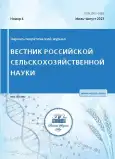Investigation of nitrogen fixation activity soybeans plants by mineral fertilizers foliar treatment
- Authors: Marzhokhova M.K.1, Kashukoev M.V2
-
Affiliations:
- Institute of Agriculture - branch of the Federal State Budgetary Scientific Institution “Federal Scientific Center "Kabardino-Balkarian Scientific Center of the Russian Academy of Sciences"
- Federal State Budgetary Educational Institution of Higher Education "Kabardino-Balkarian State Agrarian University named after V.M. Kokov"
- Issue: No 4 (2023)
- Pages: 20-24
- Section: Articles
- URL: https://journals.rcsi.science/2500-2082/article/view/141502
- DOI: https://doi.org/10.31857/2500-2082/2023/4/20-24
- EDN: https://elibrary.ru/DLPMUE
- ID: 141502
Cite item
Full Text
Abstract
About the authors
M. Kh Marzhokhova
Institute of Agriculture - branch of the Federal State Budgetary Scientific Institution “Federal Scientific Center "Kabardino-Balkarian Scientific Center of the Russian Academy of Sciences"
M. V Kashukoev
Federal State Budgetary Educational Institution of Higher Education "Kabardino-Balkarian State Agrarian University named after V.M. Kokov"
Email: mkashukoev@gmail.com
References
- Беляев Н.Н., Дубинкина Е.А. Эффективность микробиологических удобрений при обработке семян и растений сои на северо-востоке ЦЧР // Зернобобовые и крупяные культуры. 2019. № 2(30). С. 67-72. doi: 10.24411/2309-348X-2019-11091
- Береговая Ю.В., Тычинская И.Л., Петрова С.Н. и др. Сортовая специфичность эффектов ризобактерий в отношении азотфиксирующего симбиоза и минерального питания сои в условиях агроценоза // Сельскохозяйственная биология. 2018. № 5. С. 977-993.
- Васильчиков А.Г., Акулов А.С. Управление вегетацией перспективных сортообразцов сои путем применения высокоэффективных инокулянтов // Земледелие. 2018. № 4. С. 19-22. doi: 10.24411/0044-3913-2
- Васин В.Г., Саниев Р.Н., Васин А.В. и др. Применение микроудобрительных смесей и биопрепаратов при возделывании сои // Агрохимический вестник. 2019. № 2. С. 47-52.
- Доспехов Б.А. Методика полевого опыта (с основами статистической обработки результатов исследований). 5-е изд., доп. и перераб. М.: Агропромиздат, 1985. 351 с.
- Осин А.А., Осина Е.А. Роль микробиологических удобрений в повышении эффективности симбиотической деятельности, продуктивности и качества семян скороспелого сорта сои Мезенка // Зернобобовые и крупяные культуры. 2019. № 2(30). С. 84-89. doi: 10.24411/2309-348X-2019-11095
- Парахин Н.В., Осин А.А., Донская М.В. Повышение продуктивности и качества семян сои за счет интенсификации азотфиксации // Сельскохозяйственная биология. 2014. № 2. С. 118-122.
- Посыпанов Г.С. Методы изучения биологической фиксации азота воздуха. М., 1991. 300 с.
- Проворов Н.А., Онищук О.П. Эколого-генетические основы конструирования высокоэффективных азотфиксирующих микробно-растительных симбиозов // Экологическая генетика. 2019. Т. 17. № 1. С. 11-18. doi.org/10.17816/ ecogen17111-18.
- Серова Т.А., Цыганов В.Е. Старение симбиотического клубенька у бобовых растений: молекулярно-генетические и клеточные аспекты (обзор) // Сельскохозяйственная биология 2014. № 5. С. 3-15.
Supplementary files










